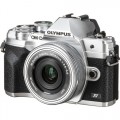Add to comparison |  |  |
|---|---|---|
| Olympus OM-D E-M10 IIIs kit 14-42 | Olympus OM-D E-M10 III kit 14-42 | |
| Outdated Product | Compare prices 1 | |
| TOP sellers | ||
| Main | 5-axis matrix stabilization. Touch screen display. Fast and tenacious autofocus. Excellent ergonomics. Wide fleet of interchangeable optics. | 5-axis matrix stabilization. Touch screen display. Fast and tenacious autofocus. Excellent ergonomics. Wide fleet of interchangeable optics. |
| Camera type | "mirrorless" (MILC) | "mirrorless" (MILC) |
Sensor | ||
| Sensor | LiveMOS /truePIC VIII processor/ | LiveMOS /truePIC VIII processor/ |
| Sensor size | 4/3" (17.3х13 mm) /17.3x13 mm/ | 4/3" (17.3х13 mm) /17.3x13 mm/ |
| Total MP | 17.2 | 17.2 |
| Effective MP number | 16 | 16 |
| Maximum image size | 4608x3456 px | 4608x3456 px |
| Light sensitivity (ISO) | 200-25600 | 200-25600 |
| RAW format recording | ||
Lens | ||
| Mount (bayonet) | Micro 4/3 | Micro 4/3 |
| Kit lens | ||
| Aperture | f/3.5 - f/5.6 | f/3.5 - f/5.6 |
| Focal length | 14 - 42 mm | 14 - 42 mm |
| Optical zoom | 3 | 3 |
| Manual focus | ||
| Image stabilization | with matrix shift /5 stops/ | with matrix shift /5 stops/ |
Photo shooting | ||
| HDR | ||
| White balance measuring | ||
| Exposure compensation | ± 5 EV, in 1/2, 1/3 or 1 EV steps | ± 5 EV, in 1/2, 1/3 or 1 EV steps |
| Auto bracketing | ||
| Exposure modes | auto shutter priority aperture priority manual mode | auto shutter priority aperture priority manual mode |
| Metering system | point centre-weighted sensor (estimated) | point centre-weighted sensor (estimated) |
Video recording | ||
| Full HD (1080) | 1920x1080 px 60 fps | 1920x1080 px 60 fps |
| Ultra HD (4K) | 3840x2160 px 30 fps | 3840x2160 px 30 fps |
| File recording formats | MPEG-4, H.264 | MPEG-4, H.264 |
| Manual video focus | ||
| Connection ports | HDMI v 1.4 | HDMI v 1.4 |
Focus | ||
| Autofocus modes | one shot tracking in face | one shot tracking in face |
| Focus points | 121 шт | 121 шт |
| Touch focus | ||
Viewfinder and shutter | ||
| Viewfinder | electronic /2036K pixels/ | electronic /2036K pixels/ |
| Viewfinder crop | 0.62 x | 0.62 x |
| Frame coverage | 100 % | 100 % |
| Shutter speed | 60-1/16000 с | 60-1/16000 с |
| Continuous shooting | 8.6 fps | 8.6 fps |
| Shutter type | electronic/mechanical | electronic/mechanical |
Screen | ||
| Screen size | 3 '' | 3 '' |
| Screen resolution | 1040 thousand pixels | 1040 thousand pixels |
| Touch screen | ||
| Rotary display | ||
Memory and communications | ||
| Memory cards types | SD, SDHC, SDXC | SD, SDHC, SDXC |
| Communications | Wi-Fi smartphone control | Wi-Fi 4 (802.11n) smartphone control |
Flash | ||
| Built-in flash | ||
| Application range | 5.8 m | 5.8 m |
| External flash connect | ||
Power source | ||
| Power source | battery | battery |
| Battery model | BLS-50 | BLS-50 |
| Shots per charge | 330 шт | 330 шт |
General | ||
| Charger model | BCS-5 | BCS-5 |
| Material | aluminium alloy | aluminium alloy |
| Retrodesign | ||
| Dimensions (WxHxD) | 122х84х50 mm | 122х84х50 mm |
| Weight | 501 g | 501 g |
| Color | ||
| Added to E-Catalog | november 2020 | september 2017 |